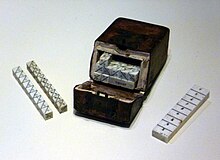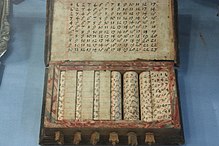
Back قضبان نابير Arabic Ossos neperians Catalan Esgyrn Napier Welsh Napiersche Rechenstäbchen German Ábaco neperiano Spanish استخوانهای نپر Persian Bâtons de Napier French עצמות נפייר HE Napierove kosti Croatian Napier-csontok Hungarian
This article has multiple issues. Please help improve it or discuss these issues on the talk page. (Learn how and when to remove these template messages)
|


| Computing devices in |
| Rabdology |
|---|
| Napier's bones |
| Promptuary |
| Location arithmetic |
Napier's bones is a manually-operated calculating device created by John Napier of Merchiston, Scotland for the calculation of products and quotients of numbers. The method was based on lattice multiplication, and also called rabdology, a word invented by Napier. Napier published his version in 1617.[1] It was printed in Edinburgh and dedicated to his patron Alexander Seton.
Using the multiplication tables embedded in the rods, multiplication can be reduced to addition operations and division to subtractions. Advanced use of the rods can extract square roots. Napier's bones are not the same as logarithms, with which Napier's name is also associated, but are based on dissected multiplication tables.
The complete device usually includes a base board with a rim; the user places Napier's rods and the rim to conduct multiplication or division. The board's left edge is divided into nine squares, holding the numbers 1 to 9. In Napier's original design, the rods are made of metal, wood or ivory and have a square cross-section. Each rod is engraved with a multiplication table on each of the four faces. In some later designs, the rods are flat and have two tables or only one engraved on them, and made of plastic or heavy cardboard. A set of such bones might be enclosed in a carrying case.
A rod's face is marked with nine squares. Each square except the top is divided into two halves by a diagonal line from the bottom left corner to the top right. The squares contain a simple multiplication table. The first holds a single digit, which Napier called the 'single'. The others hold the multiples of the single, namely twice the single, three times the single and so on up to the ninth square containing nine times the number in the top square. Single-digit numbers are written in the bottom right triangle leaving the other triangle blank, while double-digit numbers are written with a digit on either side of the diagonal.
If the tables are held on single-sided rods, 40 rods are needed in order to multiply 4-digit numbers – since numbers may have repeated digits, four copies of the multiplication table for each of the digits 0 to 9 are needed. If square rods are used, the 40 multiplication tables can be inscribed on 10 rods. Napier gave details of a scheme for arranging the tables so that no rod has two copies of the same table, enabling every possible four-digit number to be represented by 4 of the 10 rods. A set of 20 rods, consisting of two identical copies of Napier's 10 rods, allows calculation with numbers of up to eight digits, and a set of 30 rods can be used for 12-digit numbers.
- ^ John Napier (1617). Rabdologiæ (in Latin). Edinburgh, Scotland.